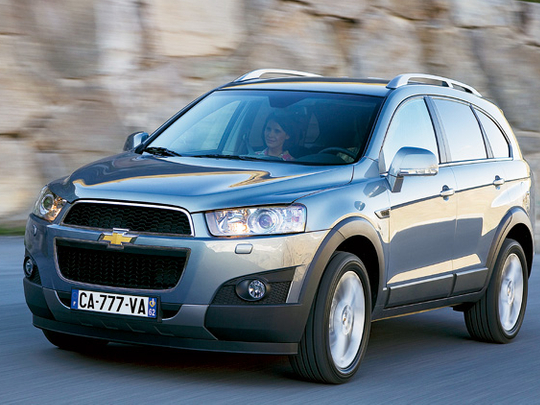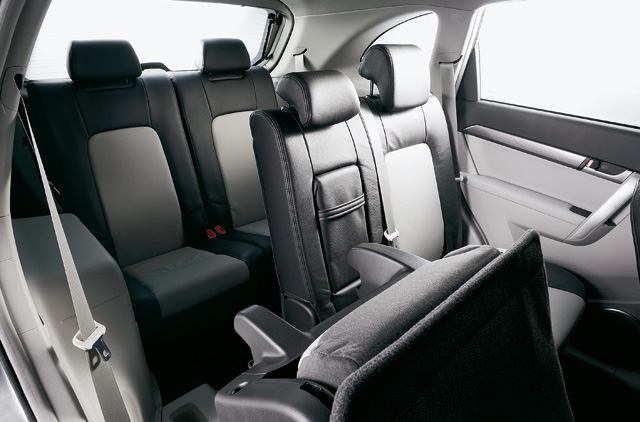
We have been getting a surfeit of crossover utility vehicles (CUVs) for review of late. Sets you thinking why carmakers are now churning them out like there was no tomorrow.
A CUV - like the new Chevrolet Captiva - is a development of the traditional SUV (sports utility vehicle), which has been criticised for its huge size, truck-based construction, economy and safety. It's another matter that most SUVs are not as comfortable or spacious as their size suggests.
Crossovers are more often than not based on a car-like unibody construction, and may be car-derived. Some have limited off-road capability - usually on-demand four-wheel drive or all-wheel drive (AWD) and are called soft-roaders. Some even have car drivetrains and suspension.
Crossovers are all the rage
So what's the reason for their popularity? They retain the SUV appearance. Some are no more than truck-styled hatches or estates on slightly elevated suspension. So, they - like the Captiva - can have car-like features. The SUV styling is retained while the size is more compact and manageable. Further, the SUV image is intact - the driver still enjoys an elevated view of the road ahead. Passengers have more space - some like the Captiva even have seven-seat versatility. However, this doesn't mean that seven adults can actually travel over long distances in relative comfort.
Storage space is generally ample, and most include towing capability. All this without compromising handling - thanks to lower ground clearance and centre of gravity, lower profile tyres, and shorter car suspension travel.
Being compact and medium-sized, crossovers are more stable and responsive on the road compared to large truck-based SUVs. Fuel economy is improved by lighter construction and lighter transmission systems.
End of the lesson: we now know why crossovers are all the rage now.
The new 2011 Chevrolet Captiva is the latest example. The previous edition was almost lost in the melee. The 2011 version tries harder - starting from its looks. The front has been spruced up with Chevrolet's signature dual mouth grille that all its new models such as the Traverse and Cruze sport. The look is distinctly more chunky and yet sporty. The lower part of the grill is integrated into the bumper. The shape of the headlights are different, and it goes with the overall design.
Inside the overload of plastics is easier on the eye - most of the plastics used are matte finish, and don't look cheap even though they're hard. The dual-cockpit look of the dashboard is enhanced by the blue backlighting. The LTZ version I drove had comfortable leather seats and satin chrome rings on the cabin vents.
The centre console has also been given a facelift with new vinyl surfacing and interior finish. It features a new digital clock, while new switches to activate the seats have been placed below the display panel. Ergonomics has also dictated repositioning of the switches for the electric wing mirrors and headlamps.
The driver's seat is electrically adjustable. All the seven seats are fine and the last row of two seats can actually seat average-sized adults if the second row is pushed forward a little. A real surprise. The second row can be easily folded forward. When the third row of seats isn't required, it can be folded flat into the floor. This will increase the cargo space to 769 litres. When both the second and third rows are folded flat, the cargo area is an impressive 1,577 litres. With all seats upright, the Captive still retains 97 litres of luggage space.
Aux-in and Bluetooth connectivity with commands integrated on the steering wheel are standard.
A smooth ride
A new ‘noise, vibration and harshness package' improves sound quality inside the cabin - audio speakers have been repositioned in the doors. Chevrolet also claims that a range of engineering improvements to the interior acoustics - including on the windshield, doors and headlining - results in reduced road, wind and engine noise. We can attest to a fairly quiet ride even at high speed on the highway.
The new Captiva is available with two new engines - a 3-litre V6, and a 2.4-litre. Both feature variable valve timing (VVT) that makes for better fuel efficiency. We drove the 3-litre version. Both are mated to new six-speed automatic transmissions.
The new 3-litre 264bhp engine - with direct fuel injection for the first time - boasts a peak torque figure of 299.7Nm. It makes for a neat little crossover with off-roading skills.
The Captiva is decent on road, the ride comfortable. The car, however, was just adequate on the highways. That may be the price to be paid for a more fuel-efficient car - Chevrolet claims a figure of 10.7 litres for every 100km.
The all-wheel drive kicks in only when the engine senses the need for extra traction. The new Captiva features the now familiar hill descent control that's useful going down steep slopes - it applies the brakes automatically without any inputs from the driver. A hill-start system stops the car from rolling back when on the incline. The six-speed automatic transmission shifts smoothly and effortlessly.
The car features active safety technologies such as ABS (anti-lock braking system), ESC (electronic stability control) and TCS (traction control system) - it ticks all the boxes.
Finally, is the new Captiva worth it? The fact remains that the car packs a lot of kit as standard. The model I drove even had ventilated leather seats. Not bad at all for around Dh92,000. The base model starts at around Dh70,000. Well worth it.
- Engine: 3-litre V6
- Transmission: Six-speed automatic, 4WD
- Maximum power: 264bhp @ 6,950rpm
- Maximum torque: 299.7Nm @ 5,100rpm
- Top speed: 198km/h
- 0-100km/h: 8.6sec
- Price: Dh92,000













